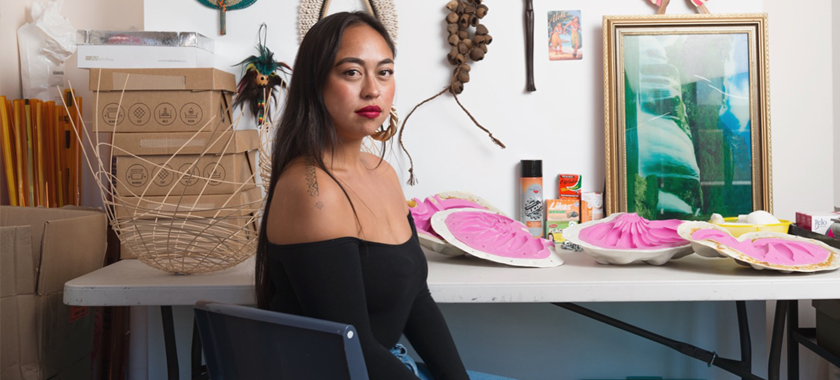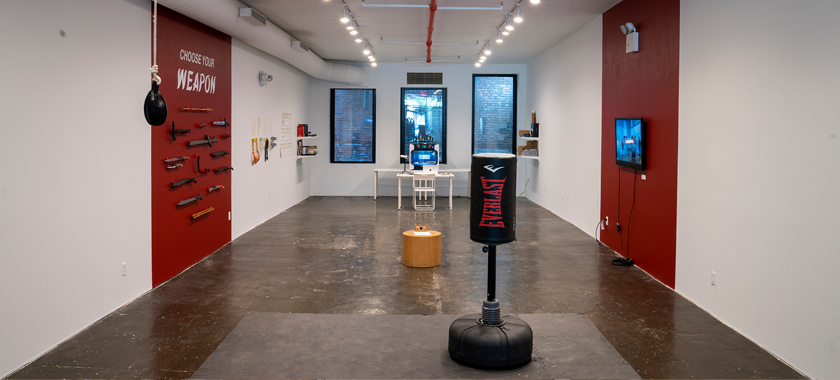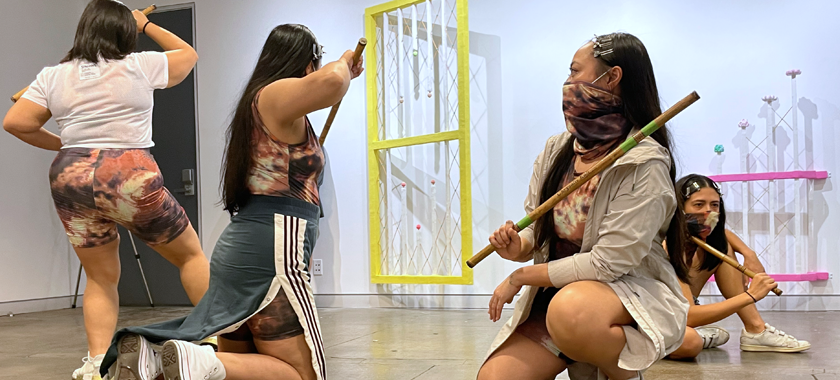
Between Journeys: A Conversation with Interdisciplinary Artist Caroline Garcia
Garcia reflects on colonialism in the context of immigration, and shares tips on locating and applying for opportunities in the arts.
A 2021 New York Artadia Awardee, a commissioned artist at The Shed and The Sydney Opera House, and a NYFA Immigrant Artist Mentoring Program mentee, interdisciplinary artist Caroline Garcia shares her tips on selecting opportunities and writing proposals, and how her experience as a first-generation Australian and New York transplant has shaped her art practice.
New York Foundation for the Arts (NYFA): Tell us about your practice. How have you and your family’s journeys between countries shaped you creatively?
Caroline Garcia: I’m an interdisciplinary artist from Sydney, Australia, and have been based in Brooklyn since 2018. I work across performance, new media, and installation through a hybridized aesthetic of cross-cultural movement and embodied research. My most recent body of work draws from Indigenous Filipino practices of headhunting and martial arts as a way to process grief—a grief from matriarchal loss—as an individual and in the postcolonial Filipinx diaspora.
My practice is shaped by the political implications of being a first-generation Australian artist whose parents immigrated from the Philippines in the ’70s. My mother was part of the first wave of non-European people to immigrate to Australia after the White Australia policy was renounced in 1973. Growing up in the aftermath of this policy (enforced in 1901) meant an experience of life with inherent conditions and treatments unfavorable towards Asians and Pacific Islanders, who were of particular concern at that time. This experience is most definitely present in my practice.
My practice is shaped by the political implications of being a first-generation Australian artist whose parents immigrated from the Philippines in the ’70s.
-Caroline Garcia
In the context of immigration (my family’s history in Eora (Sydney) and my own journey in Lenapehoking—both unceded lands), it has been important to acknowledge the many ways in which I have benefitted from settler colonialism as a person and an artist. In addition to this, being of the Philippine diaspora comes with its own ontologies and privileges concerning Indigeneity in the Philippine Islands. Addressing these concerns is an ongoing commitment I have in my practice and my personal narrative where there are a lot of transgressions occurring when existing as colonized/colonizer. I am always learning and striving to do better and this shapes the way I make art.

NYFA: As an artist who was raised in Australia and who is now based in New York, what are some differences in arts funding structures you have observed between Australia and the U.S.?
CG: I would say that funding structures are quite similar, actually. What I observed at home is that funding is more or less broken down into a national sector, state sector, and then possibly also into councils (or suburbs) within that state. I suppose this could be equivalent to nationwide in the U.S., then NY state, New York City, and then each borough as a council. If you are a resident then you are eligible to apply as an individual or with collaborators for activities such as professional development, presentation opportunities, mentorships, residencies, etc.
To be honest, I haven’t quite figured out funding structures outside of New York City, so my knowledge is limited. I’m also not sure if an “Alien Resident” would even be eligible for those! I guess the main difference that I’ve noted is the timeline of these grants—for me to apply as an Australian artist for support for projects in New York, I don’t always qualify for Australian grant deadlines, which is most challenging.
NYFA: You are a recent commissioned artist for Open Call at The Shed and a Franklin Furnace Fund Awardee. You’ve also done numerous residencies in and around the NYC area (ie CultureHub, The Studios at MASS MoCA, and Pioneer Works) and are an IAP alumna. What is your process when it comes to selecting opportunities? When writing proposals, how do you write a compelling narrative?
CG: I tend to look for opportunities where there is support (by way of stipends or honorariums, free studio space, no application fee, free exhibition opportunity, mentorship). Unfortunately, more often than not, I’m in no position to be able to self-fund an opportunity—as an immigrant artist, having leverage can be an issue—and like I mentioned above, since timelines/deadlines rarely align for Australian funding (unless it is way in advance) it can be difficult to secure support for an opportunity that requires a fee(s).
One general tip that I have is to tailor your proposal to each opportunity. I understand it can feel tedious to write applications and a lot of the questions may sound similar. Though it is easier to copy and paste pre-written responses, small tweaks or edits here and there to demonstrate why your proposal is a good fit for the specific opportunity/institution really helps.
Another tip is to be aware of the kind of language you use or your writing style. Sometimes it is unnecessary to add flourishes or be poetic or too academic, even though that’s how we may express ourselves naturally as artists. Sometimes plain, straightforward descriptions will serve you better.
Be aware of the kind of language you use or your writing style. Sometimes it is unnecessary to add flourishes or be poetic or too academic, even though that’s how we may express ourselves naturally as artists. Sometimes plain, straightforward descriptions will serve you better
-Caroline Garcia
Finally, know how to write a budget (when applicable). I never learned this in school and found it really daunting, but once I dedicated time to gain an understanding and competency, it all made sense! Oh, and make sure your work samples are on point and also tailored to the application to strengthen and support what you’ve written in your proposal.
As for a compelling story, I would say that writing from your own personal experience and not (over) generalizing can be really worthwhile. A very particular point of view can be extremely provoking, even if you haven’t quite figured out how it may manifest as an artwork.

NYFA: What’s one piece of advice you’d pass onto someone hoping to achieve a balance between applying for opportunities and making art?
CG: I would admit that I am still figuring out the balance between applying for opportunities and practicing! I find that I am consistently applying! I always joke that I do more art admin for myself than actual art making! But my advice is: to try. Apply, apply, apply.
It is worth the effort to see if a proposal lands and when it is successful, this then enables you to practice! Sometimes I find myself in a position where it is not possible to practice art (for the lack of space, funds, mental health, everyday life, etc.) and that the challenge actually is art vs. everyday life in NYC vs. mental health. It really does take a toll and it is important to check in with yourself throughout the process.
About Caroline Garcia:
Caroline Garcia is a 2021 New York Artadia Awardee and a commissioned artist for Open Call at The Shed and The Sydney Opera House’s digital exhibition, Returning. Her most notable projects include Flygirl, developed in residence at the Experimental Media and Performing Arts Center in 2016/17, and performances at the Manila Biennale, Art Central Hong Kong, and The Vera List Center for Art and Politics NYC; all in 2018.
Garcia was one of the eight artists selected nationwide for Primavera: Young Australian Artists in 2018 at the Museum of Contemporary Art Australia, and was the 2018/19 recipient of the American Australian Association’s AUSART Fellowship Award. Garcia has presented work at Lincoln Center, New York Live Arts, Spring/Break Art Fair, Elizabeth Foundation for the Arts, Movement Research at Judson Church, Smack Mellon, Creative Time Summit X, A.I.R. Biennale, and Hesse Flatow; all NYC.
She was in residence at The Studios at MASS MoCA in 2019, awarded the Edwards Charitable Giving Trust Residency at ISCP in 2020, a Tech Resident at Pioneer Works, as well as an Experimental Projects resident at the Institute for Electronic Arts in 2021. She was a CultureHub Resident, a Wave Hill Winter Workspace artist, a Franklin Furnace Grant Awardee, NYFA Immigrant Artist Program mentee, and a Recess Session artist for 2021-22. Garcia has an MFA degree in Fine Arts graduate from Parsons The New School of Art, Media, and Technology.
–Ya Yun Teng, Program Officer, Immigrant Artist Resource Center (NYC)
This post is part of the ConEdison Immigrant Artist Program Newsletter #152. Subscribe to this free monthly e-mail for artist’s features, opportunities, and events. Learn more about NYFA Immigrant Artist Mentoring Program.